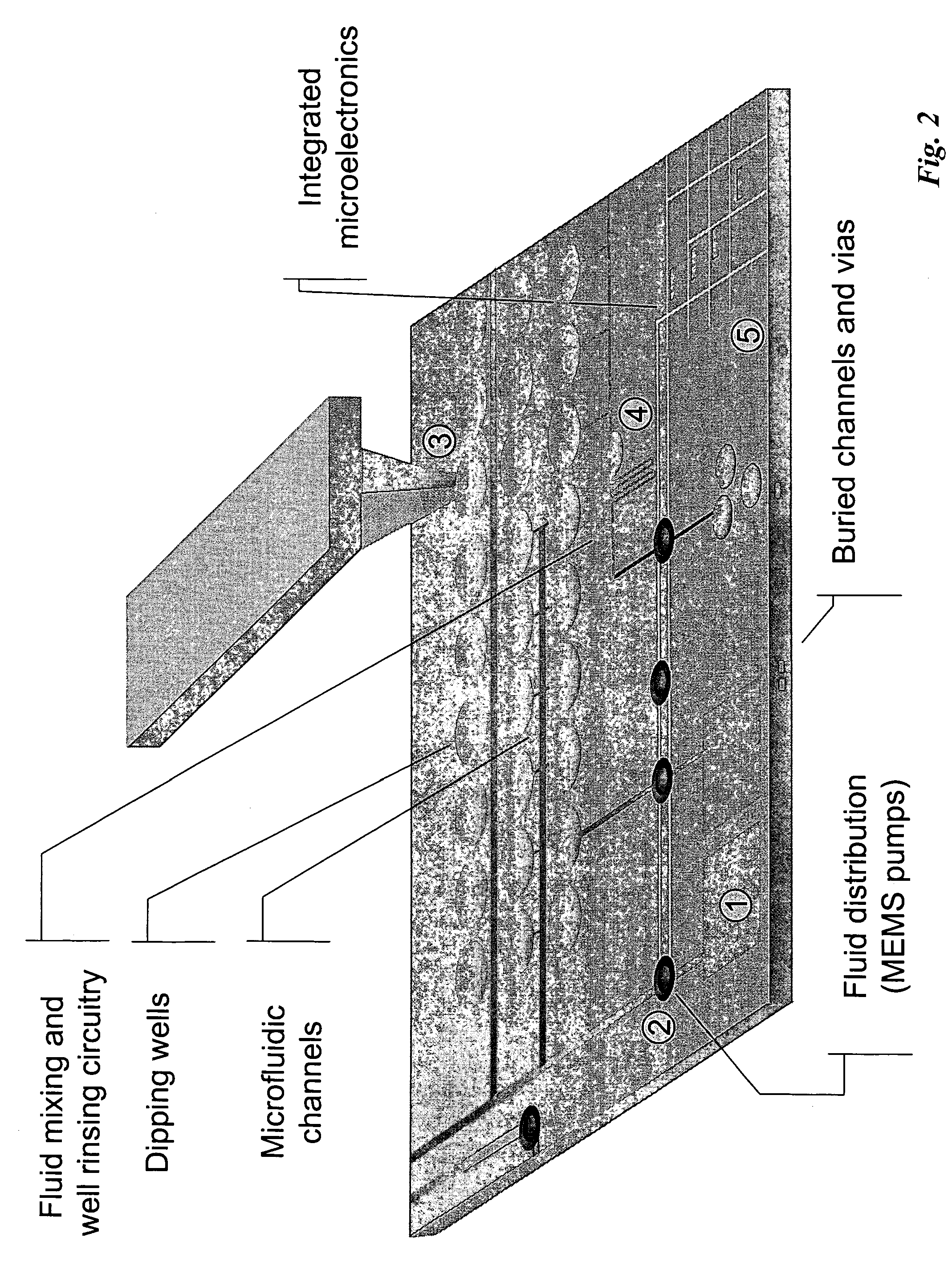Methods and apparatus for ink delivery to nanolithographic probe systems
a nanolithographic and probe technology, applied in the field of methods and apparatus for ink delivery to nanolithographic probe systems, can solve the problems of inability to achieve advanced ink delivery, inability to use nanolithographic printing ink wells and microfluidics, and many technical challenges
- Summary
- Abstract
- Description
- Claims
- Application Information
AI Technical Summary
Benefits of technology
Problems solved by technology
Method used
Image
Examples
embodiment 1
A PREFERRED EMBODIMENT 1
Well Plate Interface
[0231]A preferred embodiment, as illustrated in FIG. 9, includes: a well plate holder and well plate deck 1; a top plate 2; an alignment mechanism 3 that positions the top plate 2 in registry with the well plate underneath. The top plate 2 is equipped with: a fluid aspiration means 4, such as an array of capillaries dipping into the well plate; and microfluidic circuitry 5 that transports the fluids from the capillaries to an ink delivery mechanism 6 (e.g., a microwell array or cantilever array with integrated microfluidics). Fluid transportation may be initiated, e.g., by capillary pumping or by pressurization of the gap between the top plate and the well plate.
[0232]The well holder could be: (a) a recess with internal dimensions corresponding to the exterior dimensions of the well plate; (b) a set of corners holding the well plate in place; or (c) any other similar device. The well holder is intended to be compatible with commercial plat...
embodiment 2
A PREFERRED EMBODIMENT 2
Delivering Fluid from a Well Plate to an Ink Deposition Means Using Surface Tension Control
[0240]A substrate (e.g., wafer) may be patterned, e.g., using optical lithography or microcontact printing, to expose two or more surface chemistries with differences in their ability to be wet. Examples include, but are not limited to, patterns of thiols or silanes with different ω-functional groups [Kumar, Biebuyck, Whitesides, Langmuir 10 (5): 1498 (1994); Tarlov et al. U.S. Pat. No. 5,514,501 (1996)], the complete disclosures of which are hereby incorporated by reference]. The patterned surface chemistries circumscribe the spreading fluid in contact with the substrate to certain locations on the substrate [Drelich, Miller et al., Colloids and Surfaces 93:1–13 (1994); Gorman, Biebuyck, Whitesides, Chemistry of Materials 7(2):252 (1995), the complete disclosures of which are hereby incorporated by reference], and / or guide the fluids from one location to another, e.g.,...
embodiment 3
Preferred Embodiment 3
Simple Circuit Board-Based Probe Array
[0254]In this embodiment, the probe array is manufactured as a silicon nitride / Pyrex MEMS. The probe array may contain one or more (sealed) ink reservoir(s), from which the ink flow to the probe(s) is electrically controlled, e.g., via a MEMS valving or pumping device. The Pyrex chip is mounted directly on a printed circuit board (PCB). The chip is interconnected to the PCB either by (thermocompression / thermosonic) wire bonding or by flip-chip technology. In the first case, thin gold wires are bound between electrical pads on both the MEMS and the PCB. In the later case, vias are microfabricated in the MEMS main substrate and metallic balls are formed on the backside of the MEMS atop the via openings. The MEMS is soldered in place on matching electrical pads on the PCB or glued with conductive epoxy. The electrical interface between the PCB and the instrument consists of a miniature connector, such as those manufactured by ...
PUM
| Property | Measurement | Unit |
|---|---|---|
| contact angle | aaaaa | aaaaa |
| apex diameter | aaaaa | aaaaa |
| distance | aaaaa | aaaaa |
Abstract
Description
Claims
Application Information
 Login to View More
Login to View More - R&D
- Intellectual Property
- Life Sciences
- Materials
- Tech Scout
- Unparalleled Data Quality
- Higher Quality Content
- 60% Fewer Hallucinations
Browse by: Latest US Patents, China's latest patents, Technical Efficacy Thesaurus, Application Domain, Technology Topic, Popular Technical Reports.
© 2025 PatSnap. All rights reserved.Legal|Privacy policy|Modern Slavery Act Transparency Statement|Sitemap|About US| Contact US: help@patsnap.com



